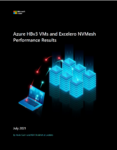Intel today announced the Aurora exascale-class supercomputer at Argonne National Laboratory is now fully equipped with 10,624 compute blades. Putting a stake in the ground, Intel said in its announcement that “later this year, Aurora is expected to be the world’s first supercomputer to achieve a theoretical peak performance of more than 2 exaflops … […]
Intel Announces Installation of Aurora Blades Is Complete, Expects System to be First to Achieve 2 ExaFLOPS
Cadence to Acquire Data Center Digital Twins Company Future Facilities
SAN JOSE — Cadence Design Systems, Inc. announced today it has agreed to acquire Future Facilities, a provider of electronics cooling analysis and energy performance optimization solutions for data centers using physics-based 3D digital twins. Terms were not disclosed. “The addition of Future Facilities’ technologies and expertise supports the Cadence Intelligent System Design strategy and […]
Post-Exascale Fabric: NNSA Awards Cornelis Networks $18M for High Performance Network R&D
Those who gave up for dead Intel’s Omni-Path fabric, which Intel began working on 2012 and stopped supporting seven years later, may want to re-think that. Cornelis Networks, the company breathing life into Omni-Path since 2020, has won an $18 million R&D contract from the U.S. National Nuclear Security Administration (NNSA). The award is part of DOE’s Next-Generation High Performance Computing Network (NG-HPCN) project….
Supermicro Announces Universal GPU System – Supports CPU, GPU and Fabric Architectures
San Jose – Super Micro Computer, Inc. (SMCI), an enterprise computing, storage, networking solutions and green computing technology company, has announced a revolutionary technology that simplifies large scale GPU deployments and is a future proof design that supports yet to be announced technologies. The Universal GPU server provides the ultimate flexibility in a resource-saving server. […]
HPE and Ayar Labs Partner to Bring Optical I/O to Slingshot Fabric for HPC and AI
HPC systems leader Hewlett Packard Enterprise and startup Ayar Labs, maker of chip-to-chip optical I/O connectivity, today announced a strategic collaboration to integrate silicon photonics within HPE’s high performance Slingshot fabric. Longer term, HPE envisions future generations of HPC systems interconnects significantly enhanced by optical I/O, which is a silicon photonics-based technology that uses light instead of electricity to transmit data. The technology addresses both the need for higher data rates and improved energy efficiency (see “Composable HPC-AI at Scale: The Emergence of Optical I/O Chiplets”).
Exascale: Rumors Circulate HPC Community Regarding Frontier’s Status
By now you may have expected a triumphant announcement from the U.S. Department of Energy that the Frontier supercomputer, slated to be installed by the end of 2021 as the first U.S. exascale-class system, has been stood up with all systems go. But as of now, DOE (whose Oak Ridge National Laboratory will house Frontier) […]
Cornelis Fabric Tapped by DOE / NNSA for Advanced Sim
Cornelis Networks announced it has been selected by the U.S. Department of Energy’s National Nuclear Security Administration (DOE/NNSA) as an HPC network provider for the NNSA’s Tri-Laboratory Commodity Technology System 2 (CTS-2) system contract. NNSA’s Advanced Simulation and Computing (ASC) program recently awarded Dell Technologies a contract to deliver computing systems totaling more than 40 petaflops to […]








